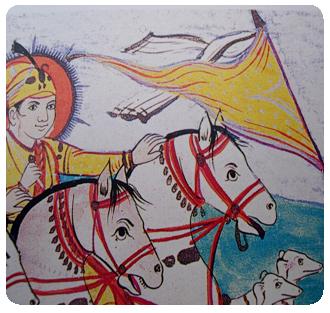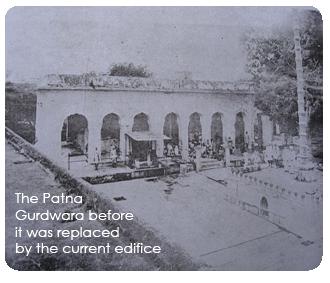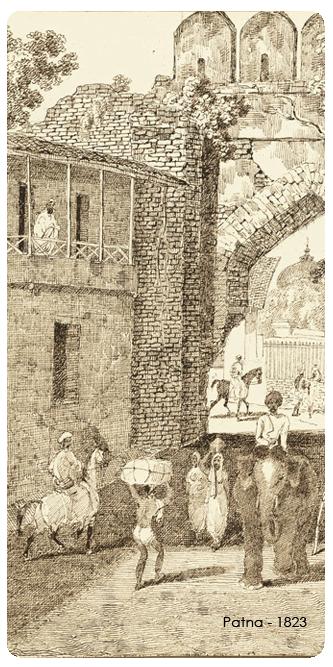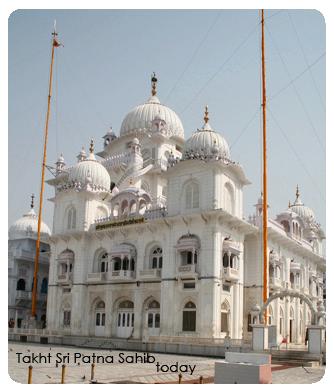 None of the recent shenanigans one hears about from the Bihar State in Eastern India have deterred me from continuing to proclaim myself a proud Bihari!
None of the recent shenanigans one hears about from the Bihar State in Eastern India have deterred me from continuing to proclaim myself a proud Bihari!
How could I not? Born and brought up in the Old City of Patna, in the land of Buddha and Mahavira, of Chandragupta, Ashoka and Channakya, where Sita was born and where the heroes of the Mahabharta gambolled, I have always revelled in the moniker.
But the clincher for my ego was that I was born not far from the birthplace and neighbourhood of young Gobind Rai - the son of Tegh Bahadar who later succeeded the latter as our Tenth Guru and, becoming the sixth soul to take Amrit on the first, historic Vaisakhi Day, transformed into Gobind Singh!
Once known as Pataliputra, the capital of the great Maurayan empire, it now honours Guru Gobind Singh in its new name: Patna Sahib.
It's my only claim to fame, but it is no small mercy for which I thank my Maker.
Being a Bihari who spent the first 21 years of his life in the State's capital city has shaped me into whatever I am today ... in so many different ways.
My childhood and early years are therefore different from that of most other Sikhs who hail from Punjab, because West Punjab is where my parents fled during the great human tragedy of Partition, and East Punjab for me was but a place to visit every now and then to visit relatives or to explore the part of Sikhdom that was now left to a diminished India. My earliest memories of Patna are, of course, of the Gurdwara. Being the birthplace of Gobind, the sprawling complex constitutes a Takht - one of the Four original Thrones (now five) of temporal authority in Sikhdom.
My earliest memories of Patna are, of course, of the Gurdwara. Being the birthplace of Gobind, the sprawling complex constitutes a Takht - one of the Four original Thrones (now five) of temporal authority in Sikhdom.
It was a much smaller edifice then. Its features remain etched in my mind since my earliest days in considerable detail, even though none of the original structure - sadly - is around today. Probably because we were there so often, and because I saw the old structure taken down ... and the new, current one built ... before my very eyes.
One of the earliest detailed accounts of Sikhs by European travelers date back to March 1, 1781 - a mere four months after Ranjit Singh was born in distant Punjab.
Sir Charles Wilkins, an eminent orientalist of the time, visited Patna on that day and wrote a marvellous account of it titled "The Seeks and Their College at Patna", which was published by The Asiatic Society in 1788.
I marvel at his description of the main building of the Gurdwara then, because it is little different from what I remember it as, from more than 170 years later. He writes:
"The whole building forms a square of about 40 feet, raised from the ground about six or eight steps. The hall is in the centre, divided from four other apartments by wooden arches upon pillars of the same materials, all neatly carved. The room is rather longer than it is broad. The floor was covered with a neat carpet ... "
The building he describes was burnt down in a fire in the early nineteenth century, and rebuilt by Ranjit Singh - by then, Maharaja of Punjab.
It must have been built along the original lines because it is the building I saw through my childhood. I remember the commotion and the massive mess and operation around the building of a grand new, monumental gurdwara, beginning around the time I was barely four years old. I remember the regular visits to do seva - as sangat from across the country came in droves to help in the construction.
I remember the commotion and the massive mess and operation around the building of a grand new, monumental gurdwara, beginning around the time I was barely four years old. I remember the regular visits to do seva - as sangat from across the country came in droves to help in the construction.
I vividly remember the hullabaloo around the arrival of Yadvinder Singh, the then Maharaja of Patiala - the late father of Amrinder Singh. It had stirred the imagination of all Indians that a Prince would dirty his hands and soil his clothes to carry cement and bricks up the scaffolding in the 'kar seva'. It seemed to give everyone added fervour ... and I remember the electricity in the air while he and his entourage did their seva, mingling freely with the rest of the sangat.
Once we moved to the new part of the city - Patna Junction, it is called - our visits to the Gurdwara continued, but were mostly limited to Sundays. Each trip therefore was an event because it involved a full day's outing since it was a dozen miles away now, and driving through the gullees of the old city - which had been demarcated centuries ago - required deft negotiations with pedestrians, horse carriages, rickshaws and cattle, all of whom claimed greater right of way.
Gurpurabs - Sikh high holidays marking important historical days such as the birth anniversaries of Guru Nanak and Guru Gobind Singh, the martyrdom anniversary of Guru Arjan, and Vaisakhi - were extra special, and we looked forward to them all year long.
The Guru Gobind Singh Gurpurab was particularly a red-letter day... nay, a week, actually!
First of all, it meant that our uncles, aunts and cousins - and friends too - from all over the country would turn up for several days. And they stayed with us ... no matter how many! Billeting merely became cosier if more than usual turned up, but 20-30 or more guests at a time staying over was not unusual. [There's a Punjabi saying: "Raise a knee, and you can snuggle in one more Singh!"]
The Gurpurab itself would be at least a full three-day affair, with programs going on all day and late into each night. The excitement, however, began in Patna Junction, around the smaller local gurdwara near the railway station, a few blocks away from where we lived. Parbhat pheris - pre-dawn rounds between Sikh homes, not unlike Christmas-time carol-singing in the West - began a couple of weeks leading up to each important gurpurab. It was a blast for us kids because it always involved the culmination of the morning at some friend's home for tea and snacks.
The excitement, however, began in Patna Junction, around the smaller local gurdwara near the railway station, a few blocks away from where we lived. Parbhat pheris - pre-dawn rounds between Sikh homes, not unlike Christmas-time carol-singing in the West - began a couple of weeks leading up to each important gurpurab. It was a blast for us kids because it always involved the culmination of the morning at some friend's home for tea and snacks.
I'd be home from boarding school for these high holidays and it would give me a chance to let my world know that I was back in town for fun and frolic.
The highlights of the Gurpurab itself were many:
The Kavi Darbar ... the Poetry Night ... was one which, oddly, even the young ones enjoyed to the hilt. Poets, raagis, singers and musicians of the highest calibre, Sikh and non-Sikh, would turn up for it and regaled us with their latest creations. It was the only time we got to hear song and music in Punjabi; they were the days before gramaphones and subsequent technology. And Bihar being a Hindi-speaking area, there was no Punjabi to be heard anywhere, on radio or otherwise.
The jaloos - a grand parade more than a couple of miles long, and trudging through several miles of the city - would take much of a second day, cutting a swathe through the teeming populace. It was always a delight because it invariably involved, unlike their poorer counterparts in the West, exotic delights: Nihangs on horses or in gatka circles, richly caparisoned camels and elephants, flower bedecked wonders posing as floats, and moving concerts on trucks by the likes of Hazara Singh Ramta, Surinder Kaur and Asa Singh Mastana. And the whole town, Sikh and non-Sikh alike, seemed to be there along the route.
My father's role during these days added a further dimension for us. He was always averse to accepting any position on the gurdwara committee, but steadily agreed to one seva which remained his till the time we left the land for Canada.
He would take on the responsibility of running the overall Langar operations - that is, the feeding of well over a hundred thousand souls three meals a day. [On special anniversaries - such as the Guru Gobind Singh Tercentenary in 1966/67 and the Guru Nanak Quincentenary in 1969 - over three hundred thousand visitors entered the city for the Gurpurab and had to be fed!]
Which meant that, despite the wall-to-wall people, I could always find him in the langar area whenever, for example, I needed urgent candy money - at any time day or night, over the three days. There was a downside to it as well - we, his kids, had no choice but to do langar seva for a minimum of one hour each morning and evening. It was a must!  The competing draws weren't easy to handle. My cousins would be waiting, and there so much to catch up with, so much to do. The bazaars too were calling ... with the aroma of street food permeating every nook and corner. And there were sumptuous sights to see - jugglers, snake charmers, animal trainers, Tibetan monks down from the mountains for the winter, fascinating yogi performers, wierd sadhus ... And yet, the lure of the kirtan jathaas too - they were the cream of the crop - was overwhelming. One saving factor was that we - all cousins - liked good kirtan, and seemed to share the same favourites.
The competing draws weren't easy to handle. My cousins would be waiting, and there so much to catch up with, so much to do. The bazaars too were calling ... with the aroma of street food permeating every nook and corner. And there were sumptuous sights to see - jugglers, snake charmers, animal trainers, Tibetan monks down from the mountains for the winter, fascinating yogi performers, wierd sadhus ... And yet, the lure of the kirtan jathaas too - they were the cream of the crop - was overwhelming. One saving factor was that we - all cousins - liked good kirtan, and seemed to share the same favourites.
The final day and night was not to be missed, not a minute of it. Through the years, Presidents, Prime Ministers, national heroes, movie stars, all would - sooner or later - turn up to pay their respects at the Gurdwara, and to address the sangat.
The climax would be on the final night when the best raagis would rev up things to a crescendo inside the main hall - the focus would shift indoors for the final hours; a few thousand would have saved places inside all day, while tens of thousands participated from the pavilions outside - when, around 2:00 am or so, the birthday service concluded.
I can't remember a single year I lived in Patna to have missed the Gurpurab!
In the Old City of Patna, there were signs of the boy Gobind Rai everywhere.
Being told the stories and taken to the very places where they had happened three centuries earlier, was like following him through the laneways as he was growing up. I fell in love with this child so full of life, and tried to imagine how it must have been for him.
I knew he had learnt to speak in the local Bihari dialects because the language comes through loud and clear, in its unadulterated sweetness, in the verses that are identified from his pen in the Dasam Granth.
This is where he played with his little friends by the well and teased the village women by aiming his catapult at their ghurraas (water pots). That is where he pulled out his play arrows and shot them at their brass pots.
The well is still there and so are some of the catapult clay balls and arrows on display, from the period.
The mansion and estate of Raja Maini and his Rani are but a short walk away, where the latter watched Gobind play and yearned for a son like him. They still serve ghuggni (black chhole) as parshad at the gurdwara where they had lived - it was little changed, furniture and all, from its original form when I was there last - the very same local dish that Gobind asked her to serve every time he visited her, assuring her that if she wanted a son like him, he would be hers too.
Head the other way and you find yourself at a ghat (dock) where the River Ganges used to whisper by; it doesn't any more, I'm told, because it has changed its course a bit. It is where the boy Gobind had lobbed his gold bracelet far into the river ... to point out exactly where he had lost his other one the day before!
I could even imagine what he wore, weaving my own image of him in my mind, based on his ancient chola (shirt) on display at the Takht Sahib, along with some other artefacts. (Not in a very good state, I'm afraid.)
All of this aroused my interest in this boy, fuelled by the saakhis of the extraordinary Man he grew up to be, from my parents and baby-sitters.
I remember that when I was but 10 years old, Brother Johnson in our Grade 7 class assigned us our Thursday essay topic - "The Most Unforgettable Character I've Met", pointing to the Reader's Digest series under that title - and urged us to chose our own subjects.
It was an easy one for me. I chose Gobind because I felt I already knew him, that he was indeed an acquaintance, nay, a friend!
By this time, there were other forces at work. Patna University at this time had a strong contingent of Sikh students, led by a charismatic young man, Bawa Jaswant Singh. He now headed The Patna Sikh Students' Association, which had developed, through the years, a good reputation as a cultural and educational group led by a new, post-Independence generation of go-getters.
Patna University at this time had a strong contingent of Sikh students, led by a charismatic young man, Bawa Jaswant Singh. He now headed The Patna Sikh Students' Association, which had developed, through the years, a good reputation as a cultural and educational group led by a new, post-Independence generation of go-getters.
I remember Bawa because he was a powerful orator. He had a thundering voice and an elephant's memory. Since my father was a Patron of the Association, he visited us often - I'll never forget a gift he once bought me for my birthday - a BB Gun!
Well, the friendship between him and my father led to my being conscripted to give a "speech" on the life of Guru Gobind Singh every December at their annual Gurpurab celebrations which were held in the University Senate Hall and had the local literati and glitterati in full attendance.
Which meant weeks of misery for a young boy not yet into his teens. It would ruin my winter holidays as I fretted over writing the speech - which was part of the deal - and, at the same time, strived desperately each year to get out of it.
The day of the actual delivery each year was not a pleasant one. I would sweat all day, first in fearful anticipation, then in my uncomfortable formal school blazer and tie - for heaven's sake, these were my winter holidays! Finally, my turn would come, and I would somehow make my way up to the podium. To my little stature, a hall full of several hundred adults, many of them VIPs, looked like a gladiatorial arena: remember, I had already seen "Quo Vadis" a few times at school by now.
As I stood under the glare, my legs would start shaking uncontrollably, until they were numb and all sensation was lost. As I struggled to hide the trembling in my voice, my next worry would be ... how was I going to get back down the stairs and back to my seat, if I couldn't even feel my legs!
Within a couple of years, after one such event, the leading local English daily - The Indian Nation - asked me for my script. I was glad to get rid of it.
The next thing I knew, it was on the front page of the weekend edition. Seeing my name in newsprint for the first time was no small boost to my self-confidence, but the usual trauma of public speaking remained for a long, long time. It would take the first two years of law school twenty years later to completely conquer the nervousness of public exposure.
But the research I was forced into in order to prepare for these speeches took me into the very heart of Guru Gobind Singh's life. The more I looked and found, the more I liked it and the hungrier I became for more.
It also began my life-long addiction to the acquisition of books!
The childish little speeches gave rise to demands for articles. Not long thereafter, S. Mohan Singh Kalra of The Sikh Review in Calcutta was in the audience. He urged me to send him stuff, and then unleashed that tyrannical monster that I still grapple with today: a deadline!
I was moved to distraction by his encouragement and wanted to try something unique, something different, something that would change the world for ever.
I turned to the credal story of Vaisakhi, but even my tender years found it extremely limiting to write a mere, regurgitated account of it.
So, I turned to fiction!
I imagined myself as Dya Ram heading into Anandpur, in answer to a call from Guru Gobind Rai for a Vaisakhi gathering ... and related the days that followed through his eyes.
Seeing it in The Sikh Review was another shot in the arm ... and I became a writer! But strangely enough, I wouldn't tackle fiction again for another forty years or so. [I wonder why!]
Add to this entire mix the fact that Patna, being a Takht, was a magnet for the most interesting characters in the world.
We lived but a stone-throw away from the Patna Junction railway station, and it was the only local stop for the national trains during my early years. The Old City being a dozen miles away, it sometimes fell on my Dad to bring home many of the visiting VIPs for the initial tea and refreshments before leading them to the Takht Sahib.
So, I had the pleasure of matching names with live faces, often in our own "drawing room", long before I fully understood what they were famous - or notorious - for.
Master Tara Singh is the earliest one I remember. Baba Gurdit Singh of the Komagata Maru was over once for dinner - and it was the first time I heard of a distant land called "Canada".
Giani Kartar Singh, Gian Singh Rarewala, Sirdar Kapur Singh, Partap Singh Kairon, Hukam Singh, Ujjal Singh, Fateh Singh ... Jai Prakash Narayan, Vinobha Bhave ...
My father would bore me to death before and after every such event, relating who the person was, what he or she had done, their historical significance, etc.
The one line - the refrain - I remember the most vividly is: "Son, remember - the ‘great' ones are no different from you or me. Only, they believe in something, they work hard, and they forge ahead!"
All of this continued with a strange twist of fate, shortly after I finished high school and joined Patna University in 1965 as a science student (yes, science!)
I was informed one day, as I came back from a holiday in the hills, that I had been elected, in absentia, the President of The Patna Sikh Students' Association. Indeed, I was a university student now and qualified ... but they had no idea that I was a mere 16 years old, despite my nascent beard and mature looks.
"Try it out for a bit!" suggested my father when he heard that I wanted to refuse the position.
What followed was an education in so many delightful ways. In short shrift, through the events and programs of a very busy and effective association, I learnt the rudiments of being a small-town impresario, a speaker, a writer, an editor, a publisher ...
I let my imagination fly and tried whatever and wherever it led me ... subject to the limitations I had in time and resources.
I was able to bring in my favourite people from across the country to wow our members and audiences at the seminars and conferences we held on or around Guru Gobind Singh.
Some, through quirks of destiny, led to life-transforming friendships.
Hardit Singh Malik fell ill a few days before he was due to fly in as a key-note speaker. He offered to come nevertheless when my mother promised to host him at our home and look after his health needs. Three days of face-to-face hero-worship with this Renaissance man led to a long pen-friendship!
Then there was the scholar Dr. Ganda Singh, who had certain diet restrictions. He stayed with us for a few days. That too led to a long friendship and his allowing me immediately to publish one of his books, "Sikhs & Sikhism" - my first publishing venture, in my teens!
The artist Kirpal Singh stood out because of his tip-to-toe black tunic and eccentric persona. I can't remember why, but he stayed with us too. Years later, after we had moved to Canada, I had the delight of reconnecting with him during a visit to Chandigarh expressly to meet up with him. He painted three masterpieces for me - one of them, at my request, of Guru Gobind Singh in The Battle of Bhangani.
Thus, in that town where I was born and where I grew up, there was nothing I touched, nothing I bumped into, that didn't remind me of The Man and of how much I owed Him.
None of all that I have described, and so much more, would have happened, or led to any good, if it hadn't been for my good fortune to be born in Gobind Rai's ‘hood and to fall in love with the life and work of Guru Gobind Singh.
Six decades later, I still marvel at this extraordinary Man - I truly know of no equal in human history - and that one simple act of his on Vaisakhi Day in 1699 on that hill-top in Anandpur, when he dropped down on his knee before newly-minted Daya Singh, Dharam Singh, Himmat Singh, Mohkam Singh and Sahib Singh and said in utter humility: "I am thy disciple ... bless me, if you will, with Amrit and make me thine, O Khalsa ji!"
